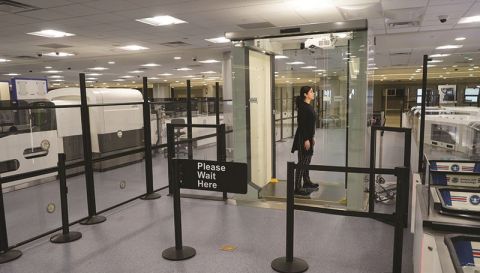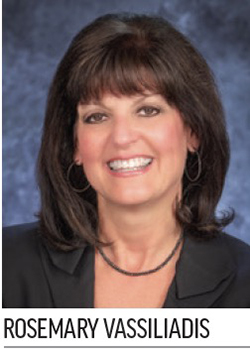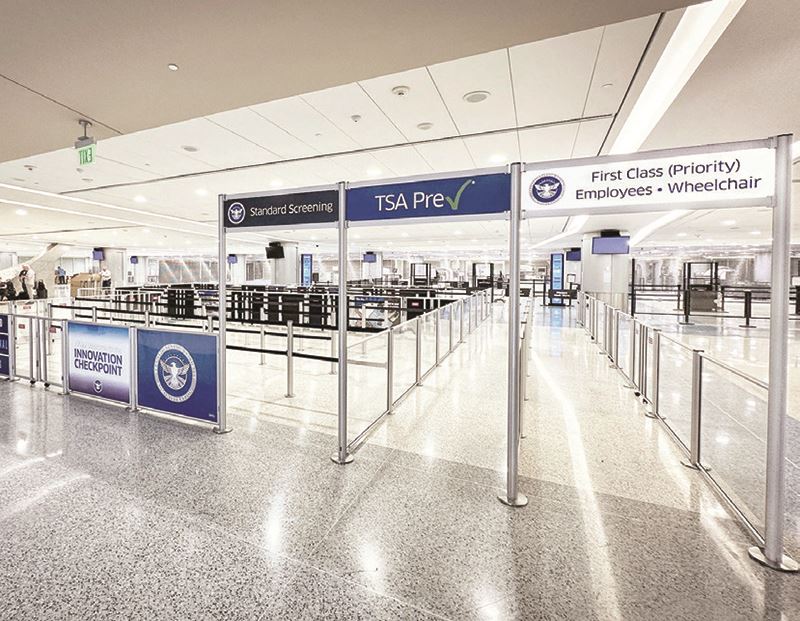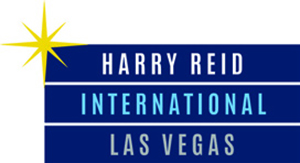Harry Reid Int’l Tests Self-Service Checkpoint

For 23 years, TSA has screened passengers and their belongings at U.S. airports to help keep air travel safe. The traffic is staggering, with an average 2.5 million people passing through checkpoints at more than 430 airports each day, and even more during holidays and other surges.
The sheer volume can easily lead to frustrating delays for travelers, but new ideas and technology to improve the process are always in the works. One of the many being considered recently took a giant leap from the lab to the field. If the prototype pans out as many hope, it could prompt a major paradigm shift for U.S. air travel.
In March, TSA began testing a self-service screening system at Harry Reid International Airport (LAS) in Las Vegas. The idea is similar to self-checkout lanes at a grocery store: Consumers initiate an automated function once performed by employees. But instead of scanning barcodes on canned soup and frozen pizzas, the system at LAS allows passengers to self-initiate full-body scans of themselves and their carry-on items for security purposes.
|
Project: Self-Service Security Checkpoint Location: Harry Reid Int’l Airport, in Las Vegas Terminal: 3
Cost: Part of TSA-funded project to test new equipment Scope: Prototype self-service screening system developed under TSA & Dept. of Homeland Security Science & Technology Directorate; Engineer: Rohde & Schwarz USA Inc. Checkpoint Lane System: Vanderlande Industries Inc. Baggage Scanning Machines: Analogic Corp. Computed Technology X-ray Machines for Passenger Screening: Analogic Corp. Automated Exit Doors: dormakaba USA Inc. Stanchions, Queue Design & Wayfinding: Lavi Industries Inc. Innovation Checkpoint Installed: 2019
3 Self-Service Development Contracts Prototype System Installed: 1st quarter 2024 Available for Passenger Use: March 2024 Key Benefits: System allows passengers to screen at own pace; flow is designed to streamline checkpoint lines & reduce need for manual screenings by TSA officers |
While the concept of self-screening is certainly novel, the technologies the system uses are anything but. Vanderlande Industries developed the lane-based system prototype using existing technologies—augmenting familiar computed tomography X-ray machines with off-the-shelf self-service components. By combining them, Vanderlande created a system designed to streamline checkpoint lines and reduce manual screenings.
Rosemary Vassiliadis, director of Aviation for Clark County, considers LAS the perfect place to test this potentially groundbreaking technology because it is a busy airport that serves a mix of business and leisure traffic. Its daily average of 158,000 passengers provides ample opportunities to analyze system efficiency, track flow, measure throughput and gather input from users and TSA personnel.
The self-service screening option at the Innovation Checkpoint in Terminal 3 is available to most TSA PreCheck passengers.
“Harry Reid International Airport is grateful for the continued partnership with the TSA to feature the nation’s only Innovation Checkpoint,” says Vassiliadis. “As an airport serving a world-class destination, we value being at the forefront of innovation. This partnership provides customers with a unique experience that they won’t receive anywhere else.”
The trial installation also benefits TSA. Real-time testing helps the federal agency assess the effectiveness of new technology before wider deployment at other airports.
Dimitri Kusnezov, undersecretary at the Department of Homeland Security for Science and Technology (S&T), seems hopeful about the proposed model. “The number of airline passengers continues to increase year over year, creating a need for innovative screening solutions that enhance transportation security and make traveling more efficient,” says Kusnezov. “S&T is pushing the envelope with innovative technologies and concepts toward designing the airport of the future. Self-paced screening is one step toward building that future.”
How it Works
Christina Peach, deputy assistant administrator for TSA Requirements and Capabilities Analysis, sees the cutting-edge system at LAS as a potential way to provide the self-driven experience many travelers want, without sacrificing safety. Peach partnered with S&T to oversee development of the self-service screening system at LAS.
“Passenger volume continues to grow year after year, and the continued investment in R&D and innovative technology solutions will help handle the increasing loads within existing airport footprints,” she says. “The concept of self-service screening is that travelers have the opportunity to go through airport screening at their own pace and with fewer interactions with TSOs.”
Another goal is minimizing the number of pat-downs and bag inspections performed by TSOs, thus freeing their time for other screening responsibilities.
TSA and S&T have been analyzing and assessing Vanderlande’s creation at the TSA Systems Integration Facility in Arlington, VA. The system features a dual-lane design that enables passengers to retrieve their carry-on items from both sides of the screening system. Video monitors at each of the six stations guide passengers through the screening process. A “Need Help” button on the bottom left of each screen connects passengers with a digital assistant for answers to standard operational questions.
Though a video screen and cameras are in place, the self-service system does not collect personally identifiable information. “This means the checkpoint system does not collect audio or video,” Peach says, noting the cameras and screens are only used to help passengers navigate.
Travelers place their carry-on items on the integrated conveyor belt and can resolve associated alarms independently without assistance from TSA personnel. Instead of divvying possessions into multiple bins, passengers put everything into a single bin and push it onto the moving belt for scanning by an Analogic computed tomography (CT) three-dimensional X-ray scanner. Carry-on bags and other personal property deemed not to pose a security threat move forward through the system for collection by passengers. If a bag contains a prohibited item, it is routed for physical inspection by a TSA officer
As their belongings are screened, passengers are directed by a TSO into one of two Advanced Imaging Technology systems on either side of the lane. An automatic door opens to invite a single passenger inside and then closes for the scanning process. An integrated video screen uses arrows and the outline of a human form to help passengers assume the correct pose. Body parts highlighted in green are positioned correctly; red highlights indicate where adjustments are needed.
If the body scanner detects something may be in a passenger’s pockets or on the passenger’s body, the glass doors open and the passenger is directed out of the scanner to place the item in a bin for screening before re-entering the body scanner.
A camera system scans bins and holds them until items are removed. When passengers are cleared for travel, the automated exit doors open, and they can retrieve their screened belongings. Empty bins are automatically returned, sparing passengers the task.
As passengers pass through the checkpoint, TSOs are present to guide and enforce security protocols. However, the goal is to empower passengers to resolve alarms themselves, reducing the need for assistance.
Win/Win
TSA Administrator David Pekoske predicts that passengers will benefit from this alternative approach because it is designed to make the airport experience safer and more convenient.
“The self-service prototype allows our trusted travelers to complete the screening process at their own pace,” says Pekoske. “Testing at the Innovation Checkpoint in Las Vegas gives us an opportunity to collect valuable user data and insights and explore possibilities to apply parts of the prototype to other airport security checkpoints.”
 Vassiliadis notes that LAS also benefits. “It allows us to expand our checkpoints for large or special events like Formula 1 or the Super Bowl,” she explains. “With the self-screening system, this checkpoint now has the capability to expand up to six lanes, so we can accommodate even more passengers. As this partnership continues, we look forward to this system playing a crucial role in the future of aviation safety and security.”
Vassiliadis notes that LAS also benefits. “It allows us to expand our checkpoints for large or special events like Formula 1 or the Super Bowl,” she explains. “With the self-screening system, this checkpoint now has the capability to expand up to six lanes, so we can accommodate even more passengers. As this partnership continues, we look forward to this system playing a crucial role in the future of aviation safety and security.”
Adding the prototype did not require significant changes to the existing checkpoint layout, as its size matches current screening systems. Cost considerations were minor because the self-service prototype includes the same major pieces of screening equipment used in standard checkpoints. “The primary additional cost is associated with the research and development of the new innovative systems,” says Peach.
The Road to Self-Screening
Development of contactless self-screening began in 2021, when S&T awarded three companies contracts to develop self-service concepts. The lane-based screening prototype recently installed at LAS passed lab testing, but the other prototypes are still in that phase.
TSA always tests systems and equipment in the lab before deploying them at the LAS Innovation Checkpoint for field-testing. Researchers not only analyze how new processes, equipment or technology works, but also how they integrate with existing processes, equipment and technology.
The Innovation Checkpoint has been in place at LAS since 2019. “We are proud that some of the technologies tested here have been deployed across the nation to enhance the passenger experience,” says Vassiliadis. These technologies include computed tomography systems with automated return bins, automated screening lanes, biometric technologies, ultraviolet sanitation lights and customer movement analytics to name a few
While the TSA Innovation Checkpoint focuses on technology to move passengers through security screening, a bottleneck remained where passengers wait for TSOs to check their boarding pass and identification.
Directing Flow
Despite the technology-driven screening process, LAS previously had antiquated systems and equipment to manage the pre-security queue, explains Perry Kuklin, marketing director at Lavi Industries, the company that designed an improved queuing system for the Innovation Checkpoint.
 “We created a modern and efficient way to move people through the pre-secure area,” says Kuklin, adding that Lavi Industries has worked with TSA since its inception.
“We created a modern and efficient way to move people through the pre-secure area,” says Kuklin, adding that Lavi Industries has worked with TSA since its inception.
Lavi improved the queue system at LAS with a modular grid layout and fixed lanes for accurate metrics. Signage for wayfinding, branding and advertising were also added.
Kuklin notes that signage and wayfinding are common issues across all airport queues. “Often these areas appear disorganized and make passengers feel uncertain about what to do,” he says. “The stanchions are haphazard, and the signage is non-existent or confusing. Passengers might get in one lane, only to find out they are in the wrong lane when they reach the front. Then they have to start over.”
Lavi resolved these issues at the Innovation Checkpoint by adding queue entrance signage. Overhead signs point the way to General Boarding, Priority or TSA PreCheck lanes. Integrated sign panels at the queue entry and along the lanes remind passengers about safety measures, how to sign up for PreCheck and more. Prior to entering the queue, passengers are given essential information on 7-foot edge-tower signs.
The company also streamlined checkpoint queues for passenger convenience. Kuklin explains that portable stanchions often get moved by crowds and cleaning crews. “This makes a queue unorganized, and an unorganized queue has a direct impact on wait times,” he explains.
To organize queues at LAS, Lavi installed steel magnetic plates in a grid pattern on the floor. The 0.1-inch-thick plates are thin enough to allow the smooth passage of wheelchairs, rolling luggage and other equipment, but strong enough to hold metal stanchions in place. The grid pattern allows staff to adjust the queue configuration as passenger volume changes.

The checkpoint design minimizes distractions for TSA officers.
“A magnetic stanchion has the benefits of a permanent stanchion. Magnetic stanchions also set the queue up for future technology solutions, such as smart gates that would allow for automatic lane configurations,” Kuklin explains. “The plates are mounted to the floor, and the stanchions to the plates; so nothing moves out of position. But the configuration isn’t permanent because stanchions are connected to the floor with a magnet, making it extremely easy to change configurations as needed.”
Clear plexiglass panels in queue lanes keep sight lines open while preventing passengers from moving into off-limit areas, he adds.
The fixed magnetic stanchions have emergency breakaway belts that snap away from the posts for emergency egress. The panel systems also have built-in gates that allow for emergency egress. If people run through them to evacuate, the belt clips snap off and allow easy passage. “Fire marshals love it because people have an emergency egress in any direction—and the magnetic stanchions will not come with them as they go through,” says Kuklin.
The new queue helps LAS accommodate K-9 operations because personnel can open up space by removing stanchions in the grid. Opaque panels are integrated into the queue to minimize visual and scent stimuli for the dogs. “It takes less than five minutes to modify the space for K-9 use,” says Kuklin.

Signage and stanchions help sort and manage passenger traffic.
Overall, he says, the new queues at LAS create an area that looks organized, feels organized and leaves passengers with a good impression of the screening process. “It has cut down on confusion and has increased efficiency,” he reports.
Feedback is Pending
Testing of the new self-service screening will likely take up to a year.
“We will collect data on system performance, design, cybersecurity and human factors,” says Peach. “The collected data will inform future design requirements, system development, and will provide TSA and S&T with critical insights into how passengers and TSOs interact with the system.”
Peach expects faster screening queues and reduced TSO interactions, but the extent of improvements will remain uncertain until enough data is gathered.
As specialists from TSA and S&T evaluate results of the beta test, many eyes are fixed on the self-service screening operation at LAS. Passengers, TSA and the airport industry as a whole are watching to see just how it performs. Whatever the outcome, TSA will continue testing new systems and technology to improve safety and the passenger experience.
FREE Whitepaper
Fairbanks International Airport Baggage Transport Conveyor Enhanced With Mod Drive™ System
Airports face a host of unique industry challenges, such as meeting efficiency regulations and seeking out the best maintenance practices to reduce costs and keep operations flowing. In today’s current economic climate, any potential cost savings can go a long way.
In 2019, Alaska’s Fairbanks International Airport (FAI) sought to modernize its equipment and operations. They were dissatisfied with the performance of the gearmotors on their baggage transport conveyors and began searching for new suppliers. Regal approached FAI with a solution that could improve equipment performance and simplify maintenance, with the added benefit of energy cost savings: the Hub City® MOD Drive™ system.
This white paper discusses the hardware deployed, the test results and the annualized expectations for ROI.
 facts&figures
facts&figures








